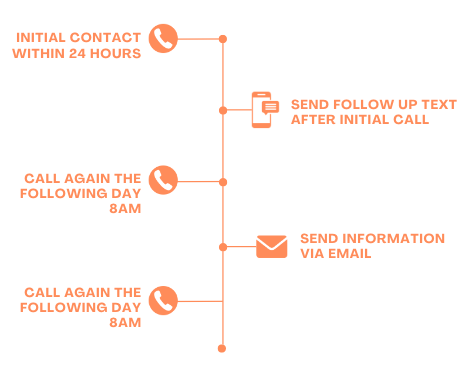As a new business owner or someone new to marketing, you might often hear the terms "lead generation" and "sales" being used interchangeably. However, while both are crucial to the success of any business, they have distinct goals, approaches, and outcomes. Understanding the difference is key to building a strong marketing and sales strategy.
In what is currently a challenging economy, people are still spending money, they are just being more selective with what they buy and who they buy from. Improving your business sales process can make a huge difference to the growth of your business.
Lead Generation vs Sales
Lead generation is all about attracting and capturing potential customers, known as leads, who have shown interest in your product or service. The primary goal here is to create a pipeline of qualified leads who are likely to become paying customers.
Leads can come from various channels, both digital and traditional. These channels include Google searches, websites, paid advertising, social media, physical assets like signage, word-of-mouth referrals, and email marketing. Once a lead has provided their contact information, the process shifts from lead generation to sales.
Sales, on the other hand, involves converting these leads into paying customers. The primary objective of sales is to close deals and generate revenue for your business. It's crucial to remember that even after leads provide their contact information, they are not yet customers. They have expressed interest by giving you permission to contact them, but building enough trust to secure a purchase or sign-up requires further engagement.
It’s common to see businesses focussed heavily on lead generation - whether that’s by word of mouth or by digital channels, but they often fall short on the sales process. Directly calling leads and adopting a "sales" mindset can feel challenging, but the key to converting leads is building trust. You know your business inside and out, and the value that you can bring to your clients.
In order for a lead to be converted, they first need to be contacted.
This sounds simple enough right? You would think so - but It’s one of the main areas of improvement that we see with our clients.
As soon as someone has expressed interest in your service, prioritise prompt and persistent contact by:
Contacting leads as soon as possible—ideally within 24 hours of receiving their information. This shows you value their interest and are keen to help.
Make at least five contact attempts. Many leads might not answer initially due to busy schedules or unfamiliar numbers. Persistence can make all the difference.
Industry standard for conversions varies, but we aim for at least 10% conversion on paid advertising efforts. That means if your business has generated 30 leads from paid advertising, you should be aiming to convert at least 3 of these. A construction company that we work with achieves, on average, 15% conversion per month, which is boosted by prompt and persistent contact.
They follow the below process when initially engaging with a lead:
This blog goes on to talk about how sales is all about qualifying leads, establishing a relationship, and building trust - but until that initial contact is achieved, these tactics can’t happen.
Leads are people too.
In our digital world driven by data and metrics, it’s easy to forget that we are dealing with real people with real needs, challenges, pain points, and desires. Successful marketing and sales strategies go beyond numbers; they revolve around building genuine relationships and trust with your potential clients. Trust is the cornerstone of any business relationship, and when someone trusts you and your service, they are far more likely to choose you over competitors.
Build Relationships, Not Just Sales:
Instead of focusing solely on closing a sale, prioritise building a relationship with your leads. Share authentic testimonials, case studies, or examples of your past work to showcase your credibility and expertise. These elements serve as social proof, demonstrating to potential clients that others have had positive experiences with your company. Transparency is also key—be open and honest about your services, pricing, and processes. This transparency not only builds trust but also sets clear expectations, laying the foundation for a positive customer experience.
Build relationships through effective communication:
Ask Quality Questions: In conversations, ask insightful questions to quickly understand the lead's needs, project specifics, budget, and timeline. This shows you are attentive and interested in providing tailored solutions.
Personalize Communication: Tailor your messages to address the specific needs and concerns of the potential client. Highlight how your services can meet their unique requirements.
Highlight Expertise: Share relevant case studies, testimonials, or examples of past projects to demonstrate your expertise and credibility. This helps to build trust and reassure the client of your capabilities.
Be Transparent: Clearly communicate your services, pricing, and processes. Transparency helps set realistic expectations and builds trust with potential clients.
Responsive and Attentive: Be prompt in responding to any questions or concerns the client may have. Show that you value their business and are committed to providing excellent service.
Consistent Follow-Up: If there is no response, follow up consistently but respectfully, using multiple channels to ensure the message is received.
Save Time: Qualify and Prioritise
Not every lead will be a perfect fit.
During your sales process it's essential to identify high-quality leads that are most likely to convert into paying clients. Qualifying your leads involves asking the right questions to determine their potential value and fit for your service, helping you prioritise your efforts and focus on the most promising leads.
High-Quality Lead: A high-quality lead might be a potential client looking to undertake a major renovation or new construction project. This lead has a clear project scope, a defined budget, and a realistic timeline. They might have already gathered some basic information about your services and expressed specific needs that align with what your company offers. For instance, they could be a homeowner looking to add a new extension to their house, with a budget of $50,000-$100,000 and a desired completion date in six months.
Low-Quality Lead: A low-quality lead, on the other hand, might be someone who is merely exploring their options or is in the very early stages of considering a project. They may not have a clear idea of what they want, lack a realistic budget, or have a timeline that doesn't align with your availability. For example, a lead asking for general information about different types of home renovations but without any specific plans, budget, or timeline is less likely to convert quickly or at all.
By identifying and prioritising high-quality leads, you can allocate your time and resources more effectively, ensuring that you focus on opportunities with the highest potential for conversion and profitability.
Patience, Persistance & Profit
Sales cycles can vary significantly from one lead to another. It's important to be patient and consistent with your follow-ups, understanding that not every potential client will be ready to commit immediately. Keep the lines of communication open, and continue to provide value through helpful information, updates, and personalised insights.
This approach not only nurtures the relationship but also ensures that you remain top of mind when the lead is ready to make a purchase decision. Remember, building trust and establishing a strong rapport are key components of a successful sales strategy.
Stay engaged, be responsive, and keep showing your potential clients why your service is the best choice for their needs.





